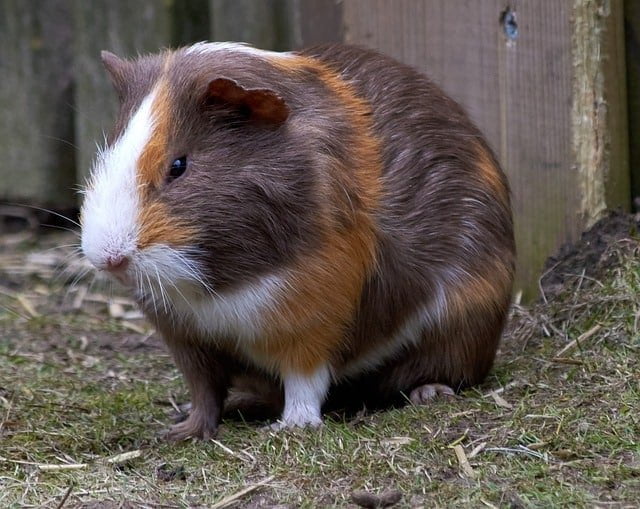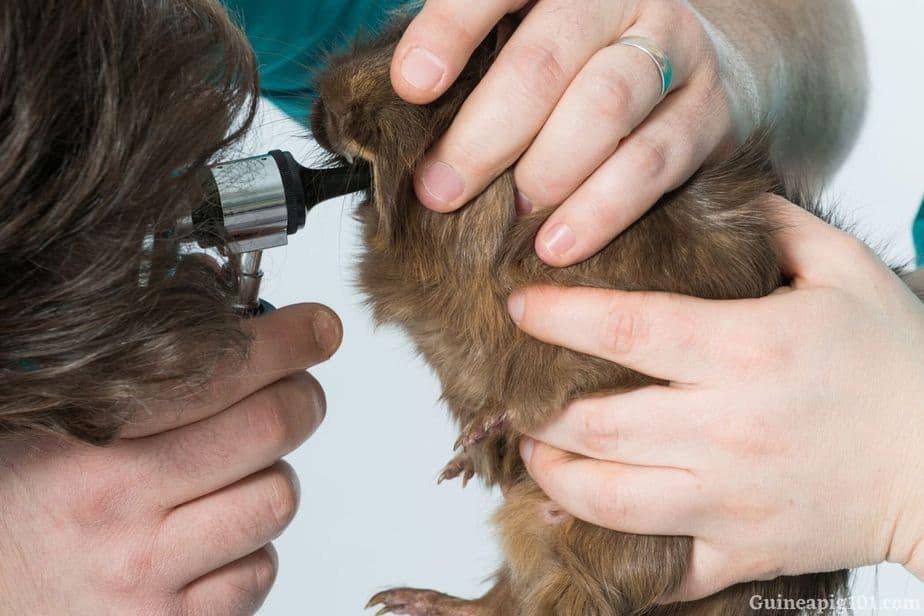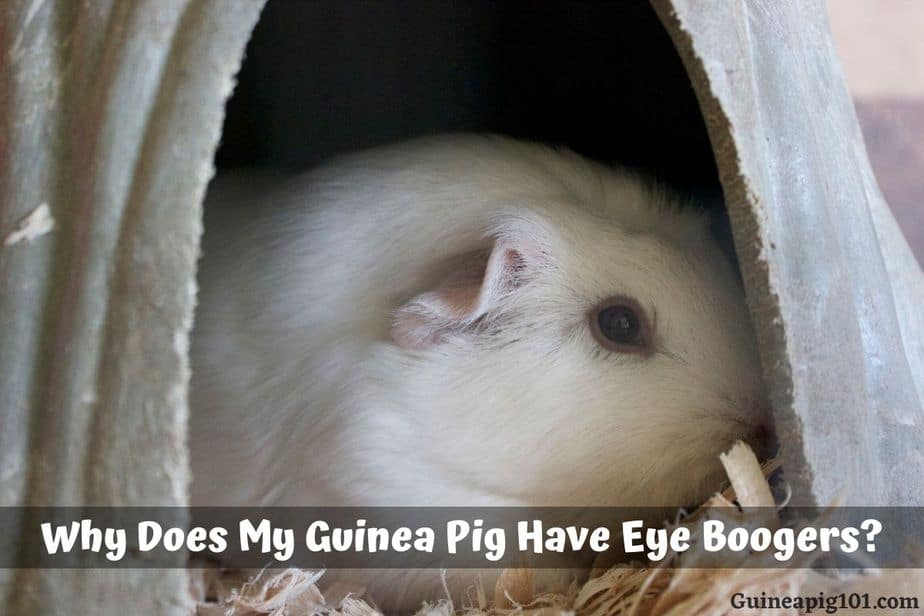Guinea pigs groom themselves well. They clean their body by licking their fur and using their paws to remove any dirt or mucus from the eyes. Sometimes the stains around the guinea pig’s eyes are stubborn and they are unable to clean that up. But why does that happen? Why does guinea pig have eye boogers?
As a curious guinea pig owner, I did some research and here is what I have learned about it.
Temporary irritation and blockage of tear duct can result in crusty eyes of guinea pigs. Conjunctivitis can also be a common cause of weepy eyes. Glaucoma and abscesses are rare but can result in eye boogers in guinea pigs. Overgrown teeth can also lead to the discharge of mucus from the eyes.
Physical problems can cause an excessive discharge of tears. Some guinea pigs may have any genetic defects as well.
If eye boogers persist for a more extended period, then we should take care of it and visit any vet if required.
It can get to a critical stage and thus it is crucial for you to learn all about it. So, without further delay lets get right into it.
Why does my guinea pig have eye discharge?
A temporary problem like irritation in the eyes can cause crusty eyes. These problems are solved after some time by guinea pigs themselves. The eyes poked with hay is an example of it.
Prolonged discharge from the eyes is considered an illness. Guinea pigs are susceptible to many eye infections. These infections are cured by the proper antibiotic course.
The mucus discharge may stick to the fur of the guinea pigs. They need to be clean as early as possible. It is normal if the problem does not recur again.
Recurring eye discharge is not a good symptom. The pet owner should look for the cause. Any sticky substance present in the eye indicates the formation of pus. Medical advice is required for such infections.
Now let us discuss in detail about what causes discharge from the eyes of guinea pigs.
1) Foreign Object Causing Eye Irritation
Guinea pigs may poke themselves with any food particle or toy. These foreign particles can irritate the eye. When you observe any discharge from the eyes, always check for the presence of any foreign particles.
The guinea pigs tend to clear the discharge with its paw. It may scratch the cornea, which enlarges the problem. The release stops when there is no more irritation in the eyes. Usually, the discharge stops within a day.
Sometimes a fur or an eyelash gets into the eye. The particle is visible as a white cloud when observed strictly. Guinea pigs keep their eyes open for most of the time, so they have a broader tendency to such problems.
Usually, guinea pigs remove the foreign particle by themselves. They wash their face to clean their eyes. You should not try to remove them using tweezers. The eyes can get harmed in the process.
Keep a watch on them for a couple of days. The eyes will get to its normal state. Treatment is required if the problem continues for a more extended period.
2) Conjunctivitis in Guinea pigs
Conjunctivitis is commonly referred to as pink eye or red eye. It results in the inflammation of the outermost layer of the eye. It is also called watery eyes due to excess of fluid discharge from the eyes.
Guinea pigs are infected with this disease due to multiple reasons. Bacterial infections are a common cause of it. Dietary deficiency of Vitamin C also causes conjunctivitis. It is also transmitted from one guinea pig to another.
Conjunctivitis occurring due to bacterial infection spreads quickly from guinea pig to another.
So, if one of the guinea pigs is infected with this disease, others are also at risk of infection. The sharing of articles increases the risk of spread.
Although conjunctivitis is not a severe disease in guinea pigs, identifying and treating it is necessary to avoid any further complications.
Symptoms of conjunctivitis in guinea pigs
The symptoms of conjunctivitis in guinea pigs include:
- Pus filled discharge
- Inflammation of the eye
- Watery tears from the eye
- Redness around the eye
- Eyelids becoming sticky
The veterinarian will observe the symptoms and conduct any tests required to confirm the disease.
Antibiotic eye drops or oral dosage is prescribed for the treatment. Cleanse the eyes with an antiseptic eyewash, before applying the eye drops.
Precaution should be taken while handling the guinea pig. Put on gloves and a mask as a safety measure.
Guinea pigs aren’t comfortable staying with conjunctivitis for a more extended period.
They get irritated as keeping the eyes open is their natural state. They also avoid food due to stress. So, immediate assistance is required to get them relief from the symptoms.
Conjunctivitis has a probability of occurring again from the inmates of the cage. While the treatment is on, care should be taken of the following steps:
- Hutch is cleaned
- Bedding and hay is changed
- Disinfect the toys and cage
- Keep the guinea pig away from the other pets in the home
Keep a watch on the improvements in the symptoms. Follow up visit to the vet is recommended.
3) Snuffles in Guinea pigs

If your guinea pig has a runny nose and drippy eyes, it may have snuffles. Snuffles is similar to the flu in humans. The treatment and care are also identical to that of the flu.
Snuffles is more dangerous for young ones and elderly guinea pigs. Healthy guinea pigs can recover from the disease if provided with enough rest.
Depending upon the health conditions of the guinea pig, antibiotics can be given. But if left untreated for a more extended period, it can be dangerous for your cavy.
Snuffles is a highly contagious disease. It can spread from one guinea pig to other inmates. If you are suffering from the flu or have any such symptoms, then it is very likely that the guinea pigs also get infected.
4) Glaucoma in Guinea pigs
Glaucoma is an infection in the eye, which causes an increase in pressure in the eye, along with an increased flow of fluids. It is not typical among guinea pigs but dangerous.
The symptoms of glaucoma are not prominent during the initial phase of infection. Eye boogers are an indication of the disease.
The eye is filled with fluid to maintain its shape and provide nourishment to the eyes. When this fluid is not drained correctly and flows to a smaller portion, it flows out in tears, forming crusty eyes.
Glaucoma may turn the eye completely blind. You should visit the vet immediately on the identification of such problems.
The vet will conduct a test to confirm the problem and prescribe eye drops. Visit the vet after regular intervals to update with the progress. If needed, change the medication.
Glaucoma cannot be treated completely. It needs care for a lifetime. You need to clean the eyes regularly and keep a watch for the symptoms of infection recurring.
Regularly and keep a watch for the symptoms of infection recurring.
Guinea pig needs constant attention once infected with glaucoma. A close bonded mate will help it in its activities and grooming.
5) Overgrown Teeth

Guinea pigs have unique oral anatomy and continuously growing teeth. They being herbivorous have open rooted incisors and cheek teeth.
Their teeth grow at a rate of 1-2mm every week. There are many health problems associated with overgrown teeth.
Overgrown teeth can cause eye discharge when the roots of the teeth grow inwards. This inward growth creates pressure on the nasal passage and results in eye discharge or nasal discharge.
Regular examination of the teeth is essential for the excellent health of the guinea pig. Prevention is better than cure, so early detection of the problem helps avoid health problems.
Eye boogers associated with overgrowth teeth can be identified by the eye discharge followed by dietary loss, pain in the mouth, and nasal discharge are common symptoms of the overgrown teeth.
Guinea pig’s teeth need regular care. The diet of the guinea pig also helps in managing the growth of the teeth. Diet rich in hay is ideal, whereas the vegetables should be provided in a limited amount.
Guinea pigs need to be provided with some stuff to chew, which helps to keep them in shape. Toys, wooden blocks, or cardboard are excellent examples of the stuff.
Consult your vet when you have symptoms related to overgrown teeth.
Trimming the teeth is done to cut short the overgrown teeth. It may be costly to get the teeth trimmed by a professional. You can try it yourself at home, with care and precautions.
6) Abscess in Guinea pigs eye
An abscess formed around the eye is a swollen part with an accumulation of pus. Abscesses host many bacteria and affect the guinea pigs. This can be caused by overgrown teeth, bite injury during any fight, etc.
Guinea pigs find it difficult to open their eyes due to the pus formation and inflammation due to abscess. Pus is discharged and leads to foul-smelling eye boogers.
An abscess can be identified by the hard capsule-like formation around the region of infection.
Guinea pigs will be sensitive to it when you even touch it. The bump accompanied by pus discharge, you may need to worry.
Abscesses can be dangerous if left untreated. It causes lots of pain. Although an abscess can be found anywhere on the body, those near the eye are more critical.
The vet will perform physical examination and tests while diagnosing. The cause of the abscess will help in the treatment of it.
Common treatment includes surgical removal, antibiotics, and drainage of the pus. Once treated, guinea pigs are susceptible to abscess again and again.
They need to be kept clean after treatment and provided with complete rest. The medication should be followed appropriately.
How do you clean a guinea pig’s eyes?
Guinea pigs like to keep themselves clean. They clean their face and eyes with the help of their paws.
Though they groom themselves well, they are unable to clean the eye boogers.
The watery secretion makes severe marks around the eyes, challenging to remove. The prolonged flow of fluids is caused due to some disease.
The eye discharge should be cleaned the instant you notice. The following steps need to be followed to clean the eyes:
- Ask someone to hold the guinea pig. Make the guinea pig comfortable and calm. It will be easy to clean the eyes.
- Take a soft cloth soaked in warm water.
- Keep the wet towel on the region near the eye. The cloth should be kept softly, and no pressure should be applied. Let the fur absorb water and dampen the eye booger.
- Wipe after a few seconds to remove the stains of the tears. Repeat the process until it doesn’t clear.
- The guinea pig can be washed using a mild shampoo. Guinea pigs are highly sensitive to chemicals, so choose the product wisely.
- Recheck the next day, if required, to clean again.
How often should I clean my guinea pig eyes
The eyes of guinea pigs need to be cleaned regularly. That can be along with general cleaning activity once a week. Avoid cleaning multiple times a week.
Guinea pigs clean themselves as a routine. They also clean their eyes while grooming themselves. So, they don’t need frequent cleaning.
The eyes should be cleaned immediately whenever you observe any discharge from the eyes.
If the release continues for more than a day, then keep a watch on the eyes. Clean the eyes at regular intervals to resolve the symptoms. Remember, cleaning does not solve the problem.
Guinea pig having such symptoms should be separated from the other inmates so that it does not spread to others.
The Guinea pig should be taken to the vet for examination and cure. It should be kept in a clean and calm place for rest. Follow the medication as prescribed by the doctor. That helps to alleviate the trouble.
Guinea pigs are highly sensitive animals and can be allergic to certain medicines. So, before you apply eye drops, the vet should be consulted.
Sources: Ocular discharge, Health Problems in Guinea Pigs, Pink Eye in Guinea Pigs, Conjunctivitis in Guinea Pigs, CDC guidelines, Optic Nerve Head and Intraocular Pressure in the Guinea Pig Eye, Dental Disease in Guinea Pigs, Abscesses in pet guinea pigs
